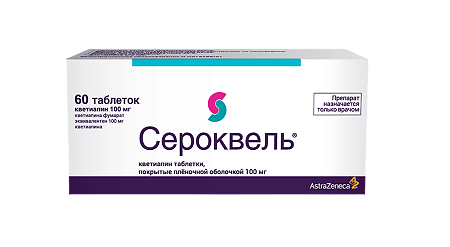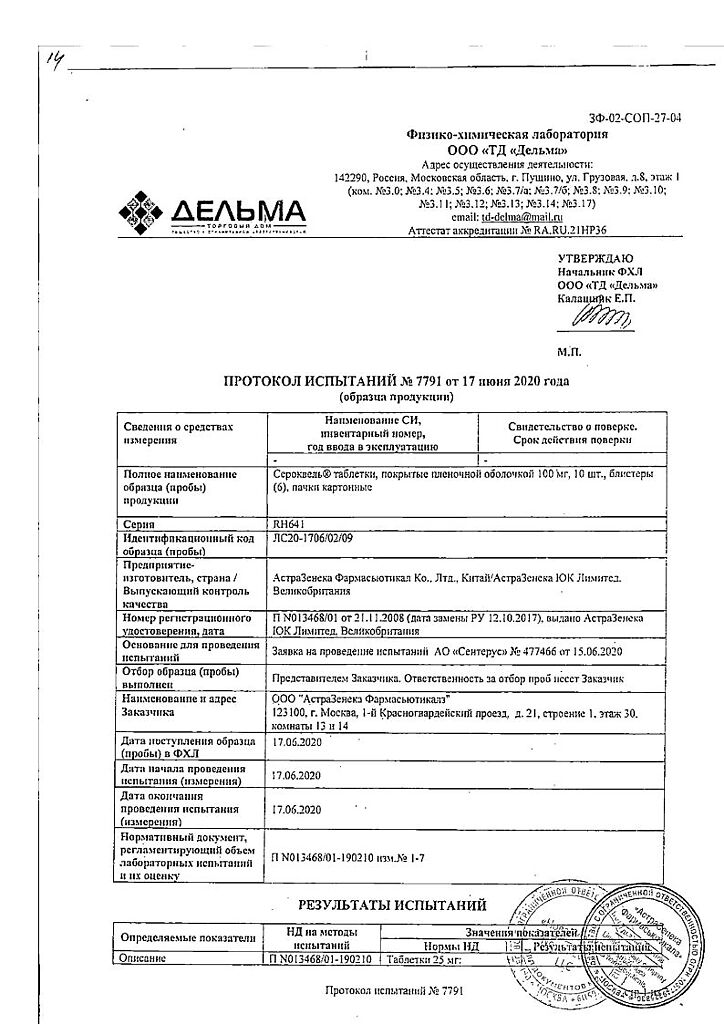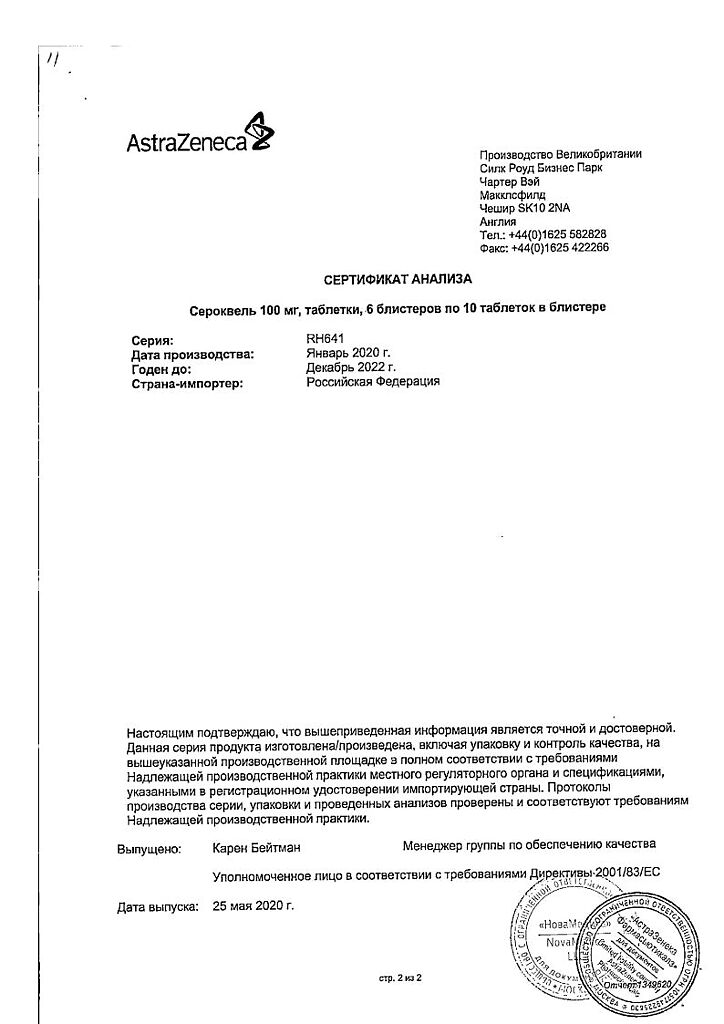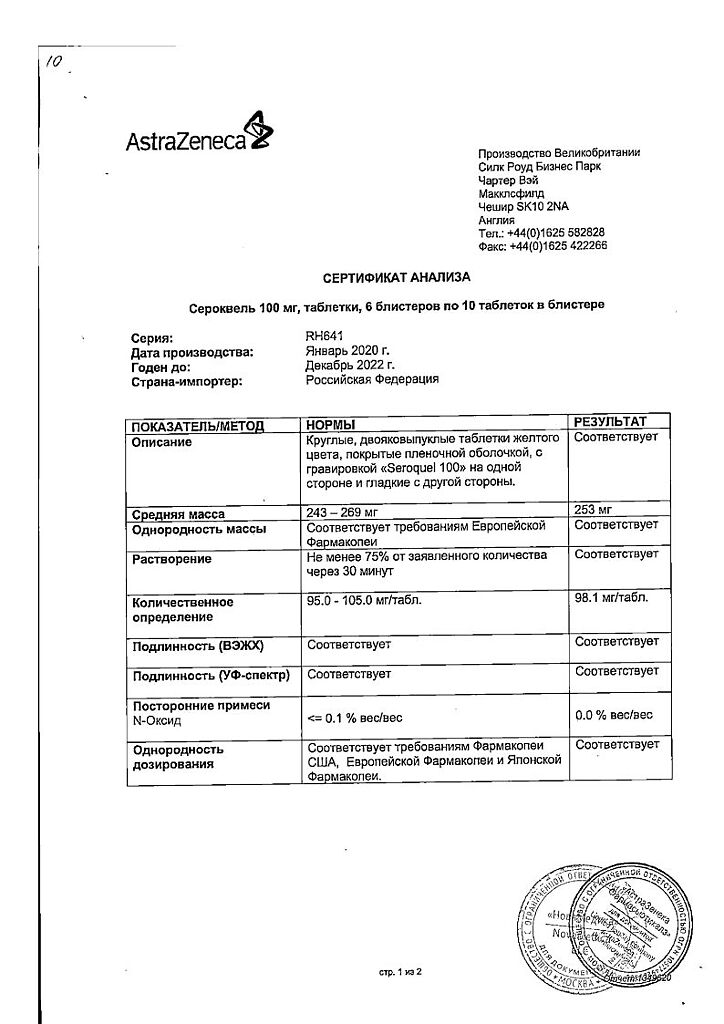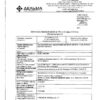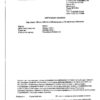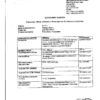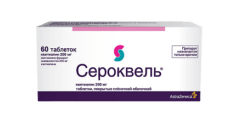No products in the cart.
Seroquel, 100 mg 60 pcs
€33.36 €27.80
Out of stock
(E-mail when Stock is available)
Description
Quetiapine is an atypical antipsychotic that has a higher affinity for serotonin receptors (5NT2) than for brain dopamine D1 and D2 receptors. Quetiapine also has a higher affinity for histamine and a1-adrenoceptors and a lower affinity for a2-adrenoceptors. Quetiapine has no detectable affinity for cholinergic muscarinic and benzodiazepine receptors. In standard tests, quetiapine shows antipsychotic activity.
Pharmacodynamic Effects
The results of studies of extrapyramidal symptoms (EPS) in animals revealed that quetiapine causes mild catalepsy at a dose that effectively blocks dopamine D2 receptors. Quetiapine causes a selective decrease in the activity of mesolimbic A10 dopaminergic neurons compared to A9 nigrostriatal neurons involved in motor function.
Clinical efficacy
The clinical studies (using Seroquel at doses of 75-750 mg/day) showed no differences between Seroquel and placebo in the incidence of extrapyramidal symptoms and concomitant use of anticholinergic drugs.
Seroquel does not cause long-term increases in plasma prolactin concentrations. Multiple fixed-dose studies have found no difference in prolactin levels when using Seroquel or placebo.
In clinical trials, Seroquel has been shown to be effective in treating both positive and negative symptoms of schizophrenia. The effects of quetiapine on 5NT2 and D2 receptors last up to 12 hours after taking the drug.
Pharmacokinetics
Quetiapine is well absorbed from the gastrointestinal tract when taken orally and is actively metabolized in the liver. The major plasma metabolites have no pronounced pharmacological activity.
The bioavailability of quetiapine is not significantly affected by food intake. The elimination half-life is about 7 hours. About 83% of quetiapine is bound to plasma proteins.
The pharmacokinetics of vetiapine are linear; there are no differences in pharmacokinetic parameters in men and women.
The average clearance of quetiapine in elderly patients is 30-50% less than in patients aged 18 to 65 years.
The mean plasma clearance of quetiapine is approximately 25% lower in patients with severe renal impairment (creatinine clearance less than 30 mL/min/1.73m2) and in patients with liver damage (stabilized alcoholic cirrhosis), but individual clearance rates are within limits consistent with healthy individuals.
Approximately 73% of quetiapine is excreted in the urine and 21% in the feces. Less than 5% of quetiapine is not metabolized and is excreted unchanged by the kidneys or in the feces
CYP3A4 has been found to be the key enzyme of cytochrome P450-mediated metabolism of quetiapine.
. In a study of the pharmacokinetics of quetiapine in different dosages, administration of quetiapine before ketoconazole or simultaneously with ketoconazole resulted in an average 235% and 522% increase in the maximum concentration (Cmax) and area under the concentration-time curve (AUC) of quetiapine, respectively, and also resulted in an average 84% decrease in quetiapine clearance. The half-life of vetiapine increased, but the mean time to reach maximum concentration (tmax) did not change.
Quetiapine and some of its metabolites have weak inhibitory activity against cytochrome P450 enzymes 1A2, 2C9, 2C19, 2D6 and WA4, but only at concentrations 10-50 times greater than those observed at the commonly used effective dose of 300-450 mg/day.
Based on in vitro results, concomitant administration of quetiapine with other drugs should not be expected to result in clinically significant inhibition of cytochrome P450 mediated metabolism of other drugs.
Indications
Indications
Acute and chronic psychoses, including schizophrenia.
Pharmacological effect
Pharmacological effect
Quetiapine is an atypical antipsychotic drug that exhibits higher affinity for serotonin receptors (5HT2) than for dopamine D1 and D2 receptors in the brain. Quetiapine also has a higher affinity for histamine and α1-adrenergic receptors and a lower affinity for α2-adrenergic receptors. No significant affinity of quetiapine for cholinergic muscarinic and benzodiazepine receptors was found. In standard tests, quetiapine exhibits antipsychotic activity.
Pharmacodynamic effects
The results of a study of extrapyramidal symptoms (EPS) in animals revealed that quetiapine causes mild catalepsy at a dose that effectively blocks dopamine D2 receptors. Quetiapine causes a selective decrease in the activity of mesolimbic A10 dopaminergic neurons compared to A9 nigrostriatal neurons involved in motor function.
Clinical effectiveness
Clinical studies (using Seroquel at a dose of 75-750 mg/day) showed no differences between the use of Seroquel and placebo in the incidence of extrapyramidal symptoms and in the concomitant use of anticholinergic drugs.
Seroquel does not cause a long-term increase in plasma prolactin concentrations. Multiple fixed-dose studies have shown no difference in prolactin levels between quetiapine and placebo.
In clinical studies, Seroquel has been shown to be effective in treating both positive and negative symptoms of schizophrenia. The effect of quetiapine on 5HT2 and D2 receptors lasts up to 12 hours after taking the drug.
Pharmacokinetics
When administered orally, quetiapine is well absorbed from the gastrointestinal tract and is actively metabolized in the liver. The main metabolites found in plasma do not have pronounced pharmacological activity.
Food intake does not significantly affect the bioavailability of quetiapine. The half-life is approximately 7 hours. Approximately 83% of quetiapine is bound to plasma proteins.
The pharmacokinetics of quetiapine is linear; there are no differences in pharmacokinetic parameters between men and women.
The average clearance of quetiapine in elderly patients is 30-50% less than in patients aged 18 to 65 years.
The average plasma clearance of quetiapine is approximately 25% less in patients with severe renal impairment (creatinine clearance less than 30 ml/min/1.73 m2) and in patients with liver damage (stable alcoholic cirrhosis), but individual clearance rates are within the range corresponding to healthy people.
Approximately 73% of quetiapine is excreted in urine and 21% in feces. Less than 5% of quetiapine is not metabolized and is excreted unchanged by the kidneys or feces
It has been established that CYP3A4 is a key enzyme in the metabolism of quetiapine, mediated by cytochrome P450.
In a study of the pharmacokinetics of quetiapine at various dosages, administering quetiapine before taking ketoconazole or concomitantly with ketoconazole led to an increase, on average, in the maximum concentration (Cmax) and area under the concentration-time curve (AUC) of quetiapine by 235% and 522%, respectively, and also led to a decrease in quetiapine clearance, on average, by 84%. The half-life of quetiapine increased, but the mean time to reach maximum concentration (tmax) did not change.
Quetiapine and some of its metabolites have weak inhibitory activity against the enzymes cytochrome P450 1A2, 2C9, 2C19, 2D6 and 3A4, but only at concentrations 10-50 times higher than those observed at the commonly used effective dosage of 300-450 mg/day.
Based on in vitro results, concomitant administration of quetiapine with other drugs should not be expected to result in clinically significant inhibition of cytochrome P450-mediated metabolism of other drugs.
Special instructions
Special instructions
Seroquel may cause orthostatic hypotension, especially during the initial dose titration period (more common in older patients than in younger patients).
There was no relationship between taking quetiapine and an increase in the QTc interval. However, when prescribing quetiapine concomitantly with drugs that prolong the QTc interval, caution must be exercised, especially in the elderly.
Given that quetiapine primarily affects the central nervous system, quetiapine should be used with caution in combination with other drugs that have a central depressant effect or alcohol.
Seizures
There were no differences in the incidence of seizures in patients taking quetiapine or placebo. However, as with other antipsychotic drugs, caution is recommended when treating patients with a history of seizures.
Neuroleptic malignant syndrome
Neuroleptic malignant syndrome may be associated with antipsychotic treatment. Clinical manifestations of the syndrome include hyperthermia, altered mental status, muscle rigidity, instability of the autonomic nervous system, and increased levels of creatine phosphokinase. In such cases, Seroquel should be discontinued and appropriate treatment administered.
Acute reactions associated with drug withdrawal
With abrupt withdrawal of high doses of antipsychotic drugs, the following acute reactions (withdrawal syndrome) may be observed: nausea, vomiting, and rarely insomnia.
Cases of exacerbation of psychotic symptoms and the appearance of involuntary movement disorders (akathisia, dystonia, dyskinesia) have been reported. Therefore, it is recommended to discontinue the drug gradually.
WITH CAUTION: in patients with cardiovascular and cerebrovascular diseases or other conditions predisposing to arterial hypotension, advanced age, liver failure, or a history of seizures.
INFLUENCE ON THE ABILITY TO DRIVE A CAR AND OTHER MECHANISMS
Seroquel may cause drowsiness, therefore, during the treatment period, patients are not recommended to work with dangerous mechanisms, including driving or drinking alcohol.
Active ingredient
Active ingredient
Quetiapine
Composition
Composition
1 film-coated tablet contains:
active ingredient:
quetiapine (as fumarate) 100 mg,
excipients:
povidone;
dibasic calcium phosphate dihydrate;
MCC;
starch (sodium glycolate);
lactose monohydrate;
magnesium stearate
shell composition:
red iron oxide (25 mg tablets); iron oxide yellow (25 and 100 mg tablets); titanium dioxide; hydroxypropyl methylcellulose; polyethylene glycol 400
Pregnancy
Pregnancy
The safety and effectiveness of quetiapine in pregnant women have not been established. Therefore, Seroquel can be used during pregnancy only if the expected benefit justifies the potential risk.
The extent of quetiapine excretion in human milk is not known. Women should be advised to avoid breastfeeding while taking Seroquel.
Contraindications
Contraindications
Hypersensitivity to any of the components of the drug Seroquel.
Side Effects
Side Effects
The following most common adverse reactions associated with taking the drug were noted: drowsiness (17.5%), dizziness (10%), constipation (9%), dyspepsia (6%), orthostatic hypotension and tachycardia (7%), dry mouth (7%), increased activity of liver enzymes in the blood serum (6%), (including increased concentrations of cholesterol and triglycerides).
Taking Seroquel may be accompanied by the development of moderate asthenia, rhinitis and dyspepsia, and an increase in body weight (mainly in the first weeks of treatment).
Seroquel may cause orthostatic hypotension (accompanied by dizziness), tachycardia and, in some patients, syncope; these adverse reactions mainly occur during the initial period of dose selection (see section “Special Instructions”).
Very rare cases of priapism and seizures have been reported in patients taking Seroquel.
In rare cases, neuroleptic malignant syndrome (hyperthermia, impaired consciousness, muscle rigidity, vegetative-vascular disorders, increased concentration of creatine phosphokinase) was observed, leukopenia and/or neutropenia was observed. There were no cases of severe neutropenia or agranulocytosis in patients taking Seroquel. When Seroquel was used in routine practice, leukopenia and/or neutropenia resolved after discontinuation of the drug. Possible risk factors for the development of leukopenia and/or neutropenia include a decrease in the number of leukocytes before starting therapy or a history of drug-induced leukopenia and/or neutropenia. Rare cases of eosinophilia, the development of peripheral edema, and allergic reactions, including angioedema, have been reported.
Cases of asymptomatic increases in serum transferase activity (alanine and aspartic ALT and AST, respectively) or gamma-glutamyl transpeptidase (GGT) activity have been reported in patients taking quetiapine. During treatment with Seroquel, these changes were usually reversible.
During treatment with Seroquel, a slight increase in the concentration of cholesterol and serum triglycerides may be observed.
Seroquel therapy is associated with a small dose-dependent decrease in thyroid hormone levels, in particular total T4 and free T4. The maximum decrease in total and free T4 was recorded in the 2nd and 4th weeks of quetiapine therapy, without a further decrease in hormone concentrations during long-term treatment. There were no further signs of clinically significant changes in thyroid-stimulating hormone concentrations.
In almost all cases, the concentration of total and free T4 returned to baseline after cessation of quetiapine therapy, regardless of the duration of treatment. Seroquel may cause a prolongation of the QTC interval; no relationship between the use of Seroquel and a permanent increase in QTC has been identified (see section “Special Instructions”). The following common (1/100) side effects have also been reported:
increased blood pressure, palpitations, dysarthria, pharyngitis, cough, anorexia, increased sweating. The cause-and-effect relationship of these side effects with the use of Seroquel has not been established.
Tardive dyskinesia
With long-term use of Seroquel, there is a potential for the development of tardive dyskinesia. If symptoms of tardive dyskinesia occur, reduce the dose or discontinue further treatment with Seroquel.
With abrupt withdrawal of high doses of antipsychotic drugs, the following acute reactions (withdrawal syndrome) may be observed: nausea, vomiting, and rarely insomnia.
Cases of exacerbation of psychotic symptoms and the appearance of involuntary movement disorders (akathisia, dystonia, dyskinesia) have been reported. Therefore, it is recommended to discontinue the drug gradually.
Interaction
Interaction
When co-administered with drugs that have a strong inhibitory effect on CYP3A4 (such as azole antifungals and macrolide antibiotics), the plasma concentration of quetiapine may increase. In such cases, lower doses of quetiapine should be used. Particular attention should be paid to elderly and debilitated patients. It is necessary to assess the risk-benefit ratio individually for each patient.
Co-administration of Seroquel with drugs that induce the liver enzyme system, such as carbamazepine, may reduce the plasma concentration of the drug, which may require an increase in the dose of Seroquel, depending on the clinical effect. In a study of the pharmacokinetics of quetiapine at various dosages, when administered before or simultaneously with carbamazepine (an inducer of liver enzymes), such simultaneous administration led to a significant increase in the clearance of quetiapine.
This increase in quetiapine clearance decreased AUC by an average of 13% compared with quetiapine without carbamazepine. The simultaneous administration of Seroquel with another inducer of microsomal liver enzymes, phenytoin, also led to an increase in the clearance of quetiapine. When quetiapine is co-administered with phenytoin (or other hepatic enzyme inducers such as barbiturates, rifampicin), an increase in the dose of quetiapine may be required. It may also be necessary to reduce the dose of Seroquel when discontinuing phenytoin or carbamazepine or another liver enzyme inducer or replacing it with a drug that does not induce liver microsomal enzymes (for example, sodium valproate).
The pharmacokinetics of lithium preparations does not change with the simultaneous administration of Seroquel.
There were no clinically significant changes in the pharmacokinetics of valproic acid and quetiapine when co-administered with divalproex sodium (sodium valproate and valproic acid in a 1:1 molar ratio) and Seroquel (quetiapine).
Quetiapine did not cause induction of hepatic enzyme systems involved in the metabolism of antipyrine.
The pharmacokinetics of quetiapine does not change significantly when administered concomitantly with the antipsychotic drugs risperidone or haloperidol. However, simultaneous administration of quetiapine and thioridazine resulted in increased clearance of quetiapine.
CYP3A4 is a key enzyme involved in the cytochrome P450-mediated metabolism of quetiapine. The pharmacokinetics of quetiapine does not change significantly with simultaneous use of cimetidine, which is a P450 inhibitor.
The pharmacokinetics of quetiapine did not change significantly when co-administered with the antidepressant imipramine (CYP2D6 inhibitor) or fluoxetine (CYP3A4 and CYP2D6 inhibitor). However, caution is recommended during concomitant use of quetiapine and systemic use of strong CYP3A4 inhibitors (such as azole antifungals and macrolide antibiotics).
CNS depressants and ethanol increase the risk of side effects.
Overdose
Overdose
Data on overdose with Seroquel are limited. Cases of taking Seroquel in doses exceeding 20 g have been described without fatal consequences and with complete recovery, however, there are reports of extremely rare cases of Seroquel overdose leading to death or coma.
Symptoms: The reported symptoms were mainly due to an increase in the known pharmacological effects of the drug, such as drowsiness and excessive sedation, tachycardia and decreased blood pressure.
Treatment: There are no specific antidotes to quetiapine. In cases of serious intoxication, it is necessary to consider the possibility of symptomatic therapy and it is recommended to carry out measures aimed at maintaining respiratory function, the cardiovascular system, ensuring adequate oxygenation and ventilation. Close medical monitoring and observation should be continued until the patient has fully recovered.
Storage conditions
Storage conditions
At a temperature not exceeding 30 °C
Shelf life
Shelf life
3 years
Manufacturer
Manufacturer
AstraZeneca Pharmaceutical Co., Ltd., China
Additional information
| Shelf life | 3 years |
|---|---|
| Conditions of storage | At a temperature not exceeding 30 °C |
| Manufacturer | AstraZeneca Pharmaceutical Co. |
| Medication form | pills |
| Brand | #Н/Д |
Other forms…
Related products
Buy Seroquel, 100 mg 60 pcs with delivery to USA, UK, Europe and over 120 other countries.

